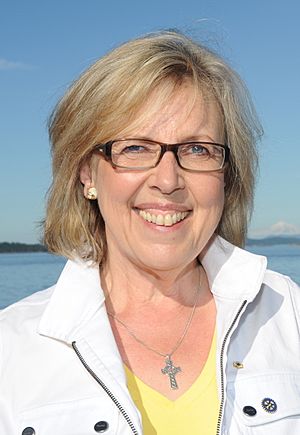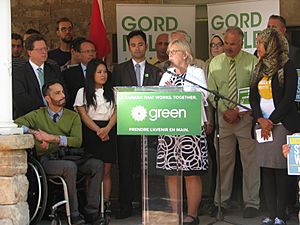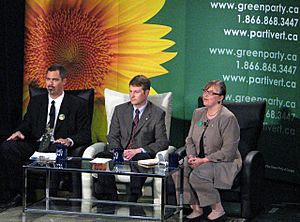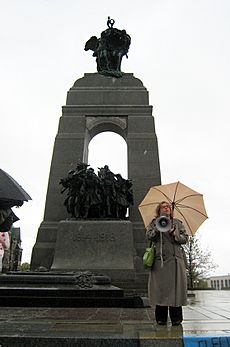Elizabeth May facts for kids
Quick facts for kids
Elizabeth May
|
|
|---|---|

May in 2014
|
|
| Leader of the Green Party | |
| Assumed office November 19, 2022 Co-leader with Jonathan Pedneault (2025)
|
|
| Deputy |
|
| Preceded by | Amita Kuttner (interim) |
| In office August 26, 2006 – November 4, 2019 |
|
| Deputy |
|
| Preceded by | Jim Harris |
| Succeeded by | Jo-Ann Roberts (interim) |
| Parliamentary Leader of the Green Party | |
| In office November 4, 2019 – November 19, 2022 |
|
| Leader |
|
| Preceded by | Position established |
| Succeeded by | Position abolished |
| Member of Parliament for Saanich—Gulf Islands |
|
| Assumed office May 2, 2011 |
|
| Preceded by | Gary Lunn |
| Personal details | |
| Born |
Elizabeth Evans May
June 9, 1954 Hartford, Connecticut, U.S. |
| Nationality |
|
| Political party | Green |
| Spouse |
John Kidder
(m. 2019) |
| Children | 1 |
| Relatives | Margot Kidder (sister-in-law) Eric Peterson (brother-in-law) |
| Alma mater | Dalhousie University |
| Occupation |
|
Elizabeth Evans May (born June 9, 1954) is a Canadian politician, environmentalist, lawyer, and author. She is well-known for her work protecting the environment. Since 2011, she has been a Member of Parliament (MP) for Saanich—Gulf Islands. An MP is someone elected to represent a specific area in the Canadian Parliament.
Elizabeth May is the leader of the Green Party of Canada. She first led the party from 2006 to 2019. She became leader again in 2022. She is the longest-serving female leader of a Canadian federal political party. She was also the first person from the Green Party to be elected to the House of Commons. From 1989 to 2006, she was the head of the Sierra Club of Canada, an environmental group.
In 2005, Elizabeth May was given the Order of Canada, which is a high honour for Canadians. The United Nations has also called her one of the world's top women environmentalists. She has written eight books, including her memoir Who We Are – Reflections of My Life and Canada.
Contents
Elizabeth May's Early Life and School
Elizabeth May was born in Hartford, Connecticut, in the United States. Her mother, Stephanie, was an artist and writer. Her father, John, was an accountant. Her mother was also a strong activist against nuclear weapons.
In 1972, her family moved to Margaree Harbour, Nova Scotia, in Canada. They bought a boat called the Marion Elizabeth and turned it into a gift shop and restaurant. They ran this business until 2002. Elizabeth May became a Canadian citizen in 1978.
She went to St. Francis Xavier University in Nova Scotia but left before finishing. Later, she took courses in restaurant management. In 1980, she started studying law at Dalhousie University in Halifax. She graduated with a law degree in 1983. She also studied theology at Saint Paul University but stopped because of her busy schedule.
Fighting for the Environment
Early Efforts to Protect Nature
Elizabeth May first became known in Canada in the mid-1970s. She led a group of volunteers who fought against spraying chemicals on forests near her home. Their efforts stopped aerial insecticide spraying in Nova Scotia. Years later, she and her neighbours went to court to stop herbicide spraying.
In 1982, they won a temporary order to stop the spraying. However, after two years, they lost the case. Her family faced financial difficulties because of the legal fight. Even though they lost, the chemicals were later banned from being exported from the U.S. This meant Nova Scotia's forests were saved from being sprayed with harmful chemicals.
In 1980, May and others started a political party called "the Small Party." This party aimed to bring attention to environmental and anti-nuclear issues. May ran in an election against a former Deputy Prime Minister. She came in last but helped raise awareness for environmental causes.
Working as an Environmental Lawyer
After finishing law school, Elizabeth May worked as an environmental lawyer in Halifax. In 1985, she moved to Ottawa to work for the Public Interest Advocacy Centre. She represented groups focused on consumers, poverty, and the environment.
In 1986, May became a Senior Policy Advisor to Thomas McMillan, who was the Minister of the Environment. In this role, she helped create the Montreal Protocol. This is an international agreement to protect the ozone layer. She also helped create several national parks, like South Moresby. In 1988, she resigned because permits were given for dams in Saskatchewan without proper environmental checks. These permits were later found to be illegal by a court.
May also helped start the Canadian Environmental Defence Fund. This fund helps groups and individuals pay for environmental legal cases. She has worked with Indigenous peoples around the world, especially in the Amazon rainforest. She also worked with First Nations in Canada. She taught courses at Queen's University and held a special position at Dalhousie University focused on women's health and the environment.
Leading the Sierra Club of Canada
In 1989, Elizabeth May became the first executive director of the Sierra Club of Canada. This is a group dedicated to protecting the environment. During her time there, she received many awards for her environmental leadership. These included the United Nations Global 500 Award in 1990. In 2005, she was made an Officer of the Order of Canada. This was to recognize her many years of leadership in the Canadian environmental movement.
In April 2006, May announced she was leaving her role at the Sierra Club. The president of the Sierra Club's board said that Elizabeth had helped the organization grow into a very effective group.
Elizabeth May's Political Journey
Becoming a Party Leader
On May 9, 2006, Elizabeth May decided to run for the leadership of the Green Party of Canada. On August 26, 2006, she won the leadership election on the first try. She received 65.3% of the votes. She said that one of her main goals would be to change the North American Free Trade Agreement (NAFTA).
May ran in a special election in London North Centre in 2006. She came in second place. This was the best result the Green Party had ever achieved in terms of percentage of votes at that time.
In 2007, May announced she would run in the Central Nova riding in Nova Scotia for the 2008 federal election. The riding was held by a Conservative minister. May chose this riding to avoid running against a Liberal or NDP candidate. The Liberal Party leader, Stéphane Dion, agreed not to run a candidate against her in Central Nova. In return, the Greens would not run a candidate in Dion's riding.
May was initially not invited to the televised national leadership debate for the 2008 Canadian federal election. This was because the Green Party did not have any elected MPs. She argued that this was unfair. Eventually, she was invited to the debate. In the 2008 election, May received 32% of the vote in Central Nova. Nationally, the Green Party received 6.8% of the votes.
Serving in Parliament
In 2010, Elizabeth May decided to run in Saanich—Gulf Islands in British Columbia. She ran against a Conservative minister. On March 29, 2011, she was again not invited to the national leaders' debate for the 2011 Canadian federal election. Despite this, she won her riding, defeating the person who held the seat. This made her the first Green Party MP elected to the House of Commons. Nationally, the Greens received 4% of the votes.
In 2012, May introduced a bill called Bill C-442. This bill aimed to create a national plan to deal with Lyme disease. On December 16, 2014, Bill C-442 became law. This was the first law passed by the Green Party in Canada's history. It passed with everyone agreeing in both parts of Parliament.
This bill was important because Lyme disease was spreading more quickly in Canada. This was partly due to climate change, which causes more ticks to spread the disease.
Every year, Maclean's Magazine holds an awards ceremony for MPs. In 2012, Elizabeth May was voted Parliamentarian of the Year by her colleagues. In 2013, she was voted Hardest Working MP. In 2014, she was voted Best Orator (speaker).
May was the first MP to speak out against Bill C-51 in 2015. This was a new anti-terror bill. She and another Green MP, Bruce Hyer, suggested sixty changes to the bill. All of their changes were rejected by the government. May later said that the bill could not be fixed and should be cancelled.
On April 23, 2015, two of May's changes to Bill C-46, the Pipelines Safety Act, were accepted. These were the first Green Party changes to a government bill ever adopted. One change made sure that Indigenous groups could be paid back for actions they took related to a spill. The other change strengthened the "polluter pays" idea. This meant that those responsible for a spill shall recover funds to help those affected, instead of just may recover them.

In October 2015, the new Prime Minister, Justin Trudeau, invited May to join the Canadian group going to the 2015 United Nations Climate Change Conference in Paris. This meeting was to discuss goals for reducing greenhouse gas emissions. May said that Trudeau's willingness to work with other parties was encouraging.
On March 23, 2018, May was arrested during a protest against the Kinder Morgan pipeline. She and other protesters were accused of breaking a court order by blocking a road near a work site. She pleaded guilty to the charge and paid a fine of $1,500. May has called for Canada to reduce its greenhouse gas emissions by 60% from 2005 levels, which is more than the current 30% target.
Leading the Green Party Again
After the previous Green Party leader, Annamie Paul, resigned, Elizabeth May announced she would run for leadership again. She ran with human rights activist Jonathan Pedneault, suggesting they lead the party together. May won the leadership election on November 19, 2022.
Since the party's rules did not officially recognize co-leaders, Pedneault served as May's deputy leader. They tried to change the party's rules, but it was not approved. On July 9, 2024, Jonathan Pedneault resigned as deputy leader for personal reasons. May said she was sad about his decision but planned to continue as leader. Pedneault returned in January 2025 to serve as co-leader, which was approved by party members on February 4, 2025. In the 2025 election, May was re-elected in her riding of Saanich—Gulf Islands.
Her Personal Life
Elizabeth May has one daughter, Victoria Cate May Burton, with her former partner Ian Burton. Her daughter also ran as a Green Party candidate in an election in 2015.
On November 27, 2018, May announced she was engaged to John Kidder. John is the brother of actress Margot Kidder. He was also one of the people who helped start the Green Party of British Columbia. May and Kidder got married on April 22, 2019, in Victoria, British Columbia.
May is a practicing Anglican, which is a type of Christian faith. She has said she is interested in becoming an Anglican priest one day. She says Jesus Christ is her personal hero because he led a peaceful revolution.
Awards and Recognitions
- International Conservation Award from Friends of Nature, 1985
- Commemorative Medal for the 125th Anniversary of the Confederation of Canada, 1992
- Elizabeth May Chair in Women's Health and the Environment, Dalhousie University, 1998
- Honorary Doctorate of Humane Letters (DHumL), Mount Saint Vincent University, 2000
- Harkin Award from the Canadian Parks and Wilderness Society for protecting Canada's wilderness, 2002
- Best Activist Award, Coast Magazine, 2002
- Honorary Doctorate of Laws, University of New Brunswick, 2003
- United Nations Global 500 award
- Officer of the Order of Canada, 2005
- Couchiching Award for Excellence in Public Policy, 2006
- Honorary Doctorate of Laws, Mount Allison University, 2007
- Newsweek magazine: One of World's Most Influential Women, 2010
- Maclean's Parliamentarian of the Year, 2012
- Canadian Version of the Queen Elizabeth II Diamond Jubilee Medal, 2012
- Maclean's Hardest Working Parliamentarian of the Year, 2013
- Maclean's Best Orator of the Year, 2014
- Honorary Doctor of Divinity (D.D.), Atlantic School of Theology, 2015
- Maclean's Most Knowledgeable Parliamentarian of the Year, 2020
Books by Elizabeth May
- Budworm battles: the fight to stop the aerial insecticide spraying of the forests of eastern Canada (with Richard E.L. Rogers). 1982.
- Paradise Won: the struggle for South Moresby. 1990.
- Frederick Street: life and death on Canada's Love Canal (with Maude Barlow). 2000. This book was about the Sydney Tar Ponds and health risks to children.
- At the cutting edge: the crisis in Canada's forests. 2005.
- How to Save the World in Your Spare Time. 2006.
- Global Warming for Dummies (with Zoe Caron). 2008.
- Losing Confidence: Power, Politics And The Crisis In Canadian Democracy. 2009.
- Who We Are: Reflections on My Life and Canada (Greystone, 2014)
See also
 In Spanish: Elizabeth May (abogada) para niños
In Spanish: Elizabeth May (abogada) para niños




